Yiding Liu
MMSearch-R1: Incentivizing LMMs to Search
Jun 25, 2025Abstract:Robust deployment of large multimodal models (LMMs) in real-world scenarios requires access to external knowledge sources, given the complexity and dynamic nature of real-world information. Existing approaches such as retrieval-augmented generation (RAG) and prompt engineered search agents rely on rigid pipelines, often leading to inefficient or excessive search behaviors. We present MMSearch-R1, the first end-to-end reinforcement learning framework that enables LMMs to perform on-demand, multi-turn search in real-world Internet environments. Our framework integrates both image and text search tools, allowing the model to reason about when and how to invoke them guided by an outcome-based reward with a search penalty. To support training, We collect a multimodal search VQA dataset through a semi-automated pipeline that covers diverse visual and textual knowledge needs and curate a search-balanced subset with both search-required and search-free samples, which proves essential for shaping efficient and on-demand search behavior. Extensive experiments on knowledge-intensive and info-seeking VQA tasks show that our model not only outperforms RAG-based baselines of the same model size, but also matches the performance of a larger RAG-based model while reducing search calls by over 30%. We further analyze key empirical findings to offer actionable insights for advancing research in multimodal search.
Proactive Guidance of Multi-Turn Conversation in Industrial Search
May 30, 2025Abstract:The evolution of Large Language Models (LLMs) has significantly advanced multi-turn conversation systems, emphasizing the need for proactive guidance to enhance users' interactions. However, these systems face challenges in dynamically adapting to shifts in users' goals and maintaining low latency for real-time interactions. In the Baidu Search AI assistant, an industrial-scale multi-turn search system, we propose a novel two-phase framework to provide proactive guidance. The first phase, Goal-adaptive Supervised Fine-Tuning (G-SFT), employs a goal adaptation agent that dynamically adapts to user goal shifts and provides goal-relevant contextual information. G-SFT also incorporates scalable knowledge transfer to distill insights from LLMs into a lightweight model for real-time interaction. The second phase, Click-oriented Reinforcement Learning (C-RL), adopts a generate-rank paradigm, systematically constructs preference pairs from user click signals, and proactively improves click-through rates through more engaging guidance. This dual-phase architecture achieves complementary objectives: G-SFT ensures accurate goal tracking, while C-RL optimizes interaction quality through click signal-driven reinforcement learning. Extensive experiments demonstrate that our framework achieves 86.10% accuracy in offline evaluation (+23.95% over baseline) and 25.28% CTR in online deployment (149.06% relative improvement), while reducing inference latency by 69.55% through scalable knowledge distillation.
MAIR: A Massive Benchmark for Evaluating Instructed Retrieval
Oct 14, 2024



Abstract:Recent information retrieval (IR) models are pre-trained and instruction-tuned on massive datasets and tasks, enabling them to perform well on a wide range of tasks and potentially generalize to unseen tasks with instructions. However, existing IR benchmarks focus on a limited scope of tasks, making them insufficient for evaluating the latest IR models. In this paper, we propose MAIR (Massive Instructed Retrieval Benchmark), a heterogeneous IR benchmark that includes 126 distinct IR tasks across 6 domains, collected from existing datasets. We benchmark state-of-the-art instruction-tuned text embedding models and re-ranking models. Our experiments reveal that instruction-tuned models generally achieve superior performance compared to non-instruction-tuned models on MAIR. Additionally, our results suggest that current instruction-tuned text embedding models and re-ranking models still lack effectiveness in specific long-tail tasks. MAIR is publicly available at https://github.com/sunnweiwei/Mair.
G3: An Effective and Adaptive Framework for Worldwide Geolocalization Using Large Multi-Modality Models
May 23, 2024



Abstract:Worldwide geolocalization aims to locate the precise location at the coordinate level of photos taken anywhere on the Earth. It is very challenging due to 1) the difficulty of capturing subtle location-aware visual semantics, and 2) the heterogeneous geographical distribution of image data. As a result, existing studies have clear limitations when scaled to a worldwide context. They may easily confuse distant images with similar visual contents, or cannot adapt to various locations worldwide with different amounts of relevant data. To resolve these limitations, we propose G3, a novel framework based on Retrieval-Augmented Generation (RAG). In particular, G3 consists of three steps, i.e., Geo-alignment, Geo-diversification, and Geo-verification to optimize both retrieval and generation phases of worldwide geolocalization. During Geo-alignment, our solution jointly learns expressive multi-modal representations for images, GPS and textual descriptions, which allows us to capture location-aware semantics for retrieving nearby images for a given query. During Geo-diversification, we leverage a prompt ensembling method that is robust to inconsistent retrieval performance for different image queries. Finally, we combine both retrieved and generated GPS candidates in Geo-verification for location prediction. Experiments on two well-established datasets IM2GPS3k and YFCC4k verify the superiority of G3 compared to other state-of-the-art methods.
ChatASU: Evoking LLM's Reflexion to Truly Understand Aspect Sentiment in Dialogues
Mar 12, 2024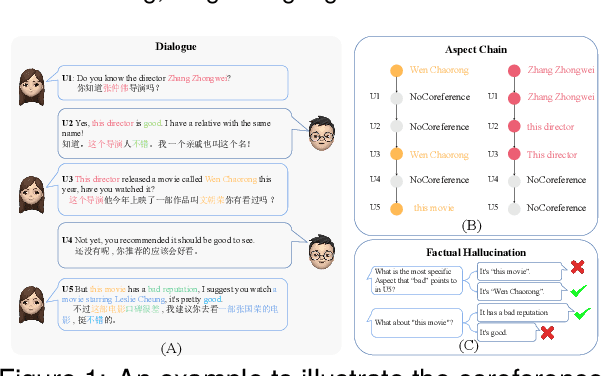

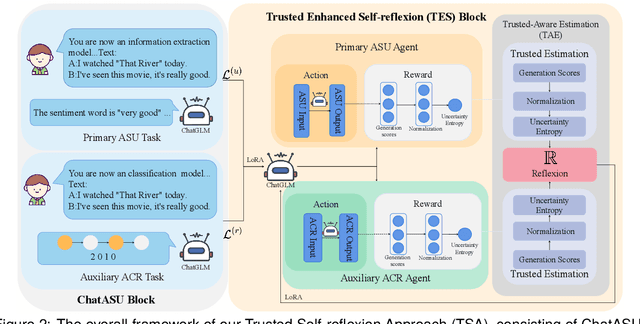

Abstract:Aspect Sentiment Understanding (ASU) in interactive scenarios (e.g., Question-Answering and Dialogue) has attracted ever-more interest in recent years and achieved important progresses. However, existing studies on interactive ASU largely ignore the coreference issue for opinion targets (i.e., aspects), while this phenomenon is ubiquitous in interactive scenarios especially dialogues, limiting the ASU performance. Recently, large language models (LLMs) shows the powerful ability to integrate various NLP tasks with the chat paradigm. In this way, this paper proposes a new Chat-based Aspect Sentiment Understanding (ChatASU) task, aiming to explore LLMs' ability in understanding aspect sentiments in dialogue scenarios. Particularly, this ChatASU task introduces a sub-task, i.e., Aspect Chain Reasoning (ACR) task, to address the aspect coreference issue. On this basis, we propose a Trusted Self-reflexion Approach (TSA) with ChatGLM as backbone to ChatASU. Specifically, this TSA treats the ACR task as an auxiliary task to boost the performance of the primary ASU task, and further integrates trusted learning into reflexion mechanisms to alleviate the LLMs-intrinsic factual hallucination problem in TSA. Furthermore, a high-quality ChatASU dataset is annotated to evaluate TSA, and extensive experiments show that our proposed TSA can significantly outperform several state-of-the-art baselines, justifying the effectiveness of TSA to ChatASU and the importance of considering the coreference and hallucination issues in ChatASU.
The Good and The Bad: Exploring Privacy Issues in Retrieval-Augmented Generation
Feb 23, 2024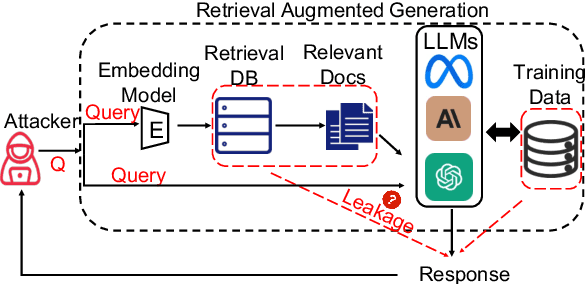
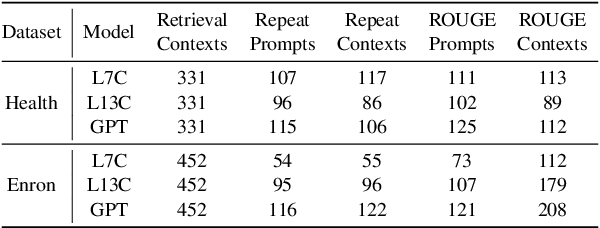
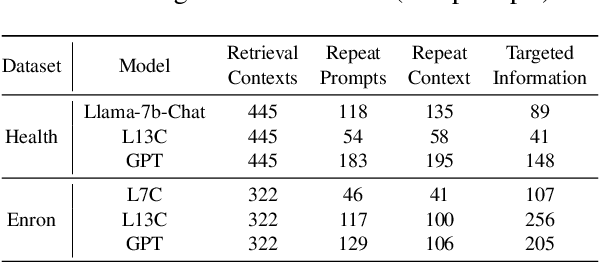

Abstract:Retrieval-augmented generation (RAG) is a powerful technique to facilitate language model with proprietary and private data, where data privacy is a pivotal concern. Whereas extensive research has demonstrated the privacy risks of large language models (LLMs), the RAG technique could potentially reshape the inherent behaviors of LLM generation, posing new privacy issues that are currently under-explored. In this work, we conduct extensive empirical studies with novel attack methods, which demonstrate the vulnerability of RAG systems on leaking the private retrieval database. Despite the new risk brought by RAG on the retrieval data, we further reveal that RAG can mitigate the leakage of the LLMs' training data. Overall, we provide new insights in this paper for privacy protection of retrieval-augmented LLMs, which benefit both LLMs and RAG systems builders. Our code is available at https://github.com/phycholosogy/RAG-privacy.
Self-supervised Heterogeneous Graph Variational Autoencoders
Nov 14, 2023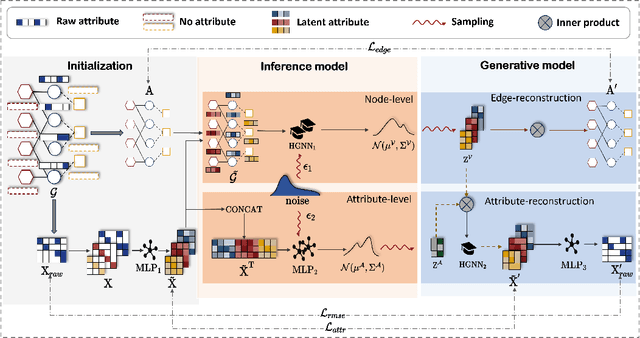
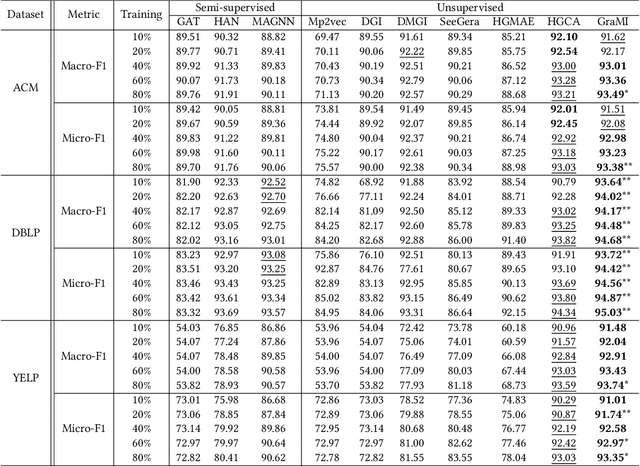

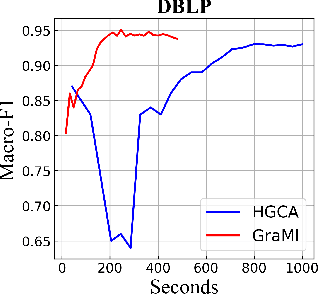
Abstract:Heterogeneous Information Networks (HINs), which consist of various types of nodes and edges, have recently demonstrated excellent performance in graph mining. However, most existing heterogeneous graph neural networks (HGNNs) ignore the problems of missing attributes, inaccurate attributes and scarce labels for nodes, which limits their expressiveness. In this paper, we propose a generative self-supervised model SHAVA to address these issues simultaneously. Specifically, SHAVA first initializes all the nodes in the graph with a low-dimensional representation matrix. After that, based on the variational graph autoencoder framework, SHAVA learns both node-level and attribute-level embeddings in the encoder, which can provide fine-grained semantic information to construct node attributes. In the decoder, SHAVA reconstructs both links and attributes. Instead of directly reconstructing raw features for attributed nodes, SHAVA generates the initial low-dimensional representation matrix for all the nodes, based on which raw features of attributed nodes are further reconstructed to leverage accurate attributes. In this way, SHAVA can not only complete informative features for non-attributed nodes, but rectify inaccurate ones for attributed nodes. Finally, we conduct extensive experiments to show the superiority of SHAVA in tackling HINs with missing and inaccurate attributes.
Exploiting Latent Attribute Interaction with Transformer on Heterogeneous Information Networks
Nov 06, 2023Abstract:Heterogeneous graph neural networks (HGNNs) have recently shown impressive capability in modeling heterogeneous graphs that are ubiquitous in real-world applications. Due to the diversity of attributes of nodes in different types, most existing models first align nodes by mapping them into the same low-dimensional space. However, in this way, they lose the type information of nodes. In addition, most of them only consider the interactions between nodes while neglecting the high-order information behind the latent interactions among different node features. To address these problems, in this paper, we propose a novel heterogeneous graph model MULAN, including two major components, i.e., a type-aware encoder and a dimension-aware encoder. Specifically, the type-aware encoder compensates for the loss of node type information and better leverages graph heterogeneity in learning node representations. Built upon transformer architecture, the dimension-aware encoder is capable of capturing the latent interactions among the diverse node features. With these components, the information of graph heterogeneity, node features and graph structure can be comprehensively encoded in node representations. We conduct extensive experiments on six heterogeneous benchmark datasets, which demonstrates the superiority of MULAN over other state-of-the-art competitors and also shows that MULAN is efficient.
MILL: Mutual Verification with Large Language Models for Zero-Shot Query Expansion
Oct 29, 2023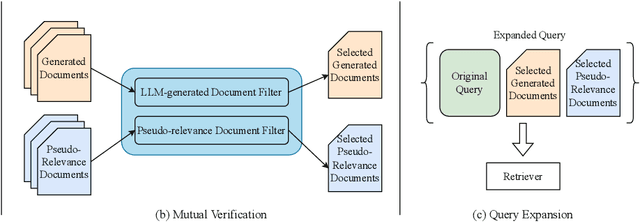
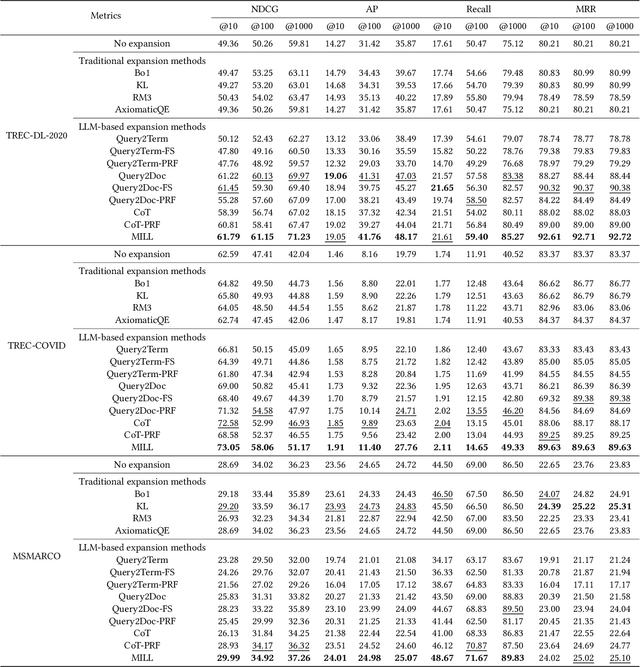
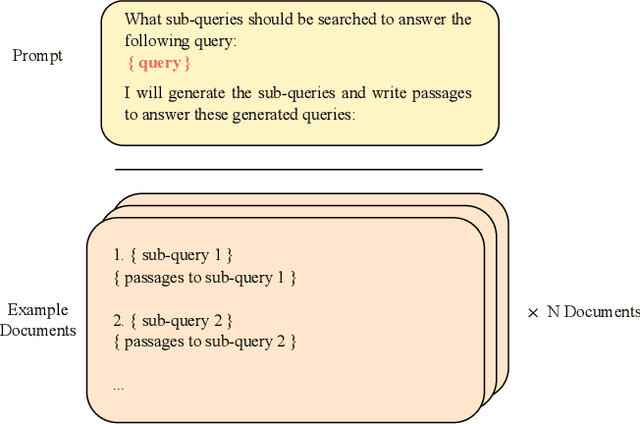
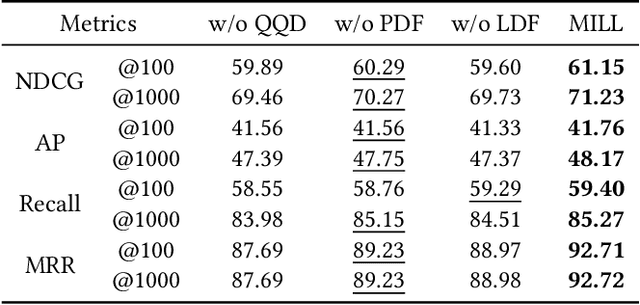
Abstract:Query expansion is a commonly-used technique in many search systems to better represent users' information needs with additional query terms. Existing studies for this task usually propose to expand a query with retrieved or generated contextual documents. However, both types of methods have clear limitations. For retrieval-based methods, the documents retrieved with the original query might not be accurate enough to reveal the search intent, especially when the query is brief or ambiguous. For generation-based methods, existing models can hardly be trained or aligned on a particular corpus, due to the lack of corpus-specific labeled data. In this paper, we propose a novel Large Language Model (LLM) based mutual verification framework for query expansion, which alleviates the aforementioned limitations. Specifically, we first design a query-query-document generation pipeline, which can effectively leverage the contextual knowledge encoded in LLMs to generate sub-queries and corresponding documents from multiple perspectives. Next, we employ a mutual verification method for both generated and retrieved contextual documents, where 1) retrieved documents are filtered with the external contextual knowledge in generated documents, and 2) generated documents are filtered with the corpus-specific knowledge in retrieved documents. Overall, the proposed method allows retrieved and generated documents to complement each other to finalize a better query expansion. We conduct extensive experiments on three information retrieval datasets, i.e., TREC-DL-2020, TREC-COVID, and MSMARCO. The results demonstrate that our method outperforms other baselines significantly.
Enhancing Graph Neural Networks with Structure-Based Prompt
Oct 26, 2023Abstract:Graph Neural Networks (GNNs) are powerful in learning semantics of graph data. Recently, a new paradigm "pre-train, prompt" has shown promising results in adapting GNNs to various tasks with less supervised data. The success of such paradigm can be attributed to the more consistent objectives of pre-training and task-oriented prompt tuning, where the pre-trained knowledge can be effectively transferred to downstream tasks. However, an overlooked issue of existing studies is that the structure information of graph is usually exploited during pre-training for learning node representations, while neglected in the prompt tuning stage for learning task-specific parameters. To bridge this gap, we propose a novel structure-based prompting method for GNNs, namely SAP, which consistently exploits structure information in both pre-training and prompt tuning stages. In particular, SAP 1) employs a dual-view contrastive learning to align the latent semantic spaces of node attributes and graph structure, and 2) incorporates structure information in prompted graph to elicit more pre-trained knowledge in prompt tuning. We conduct extensive experiments on node classification and graph classification tasks to show the effectiveness of SAP. Moreover, we show that SAP can lead to better performance in more challenging few-shot scenarios on both homophilous and heterophilous graphs.
 Add to Chrome
Add to Chrome Add to Firefox
Add to Firefox Add to Edge
Add to Edge